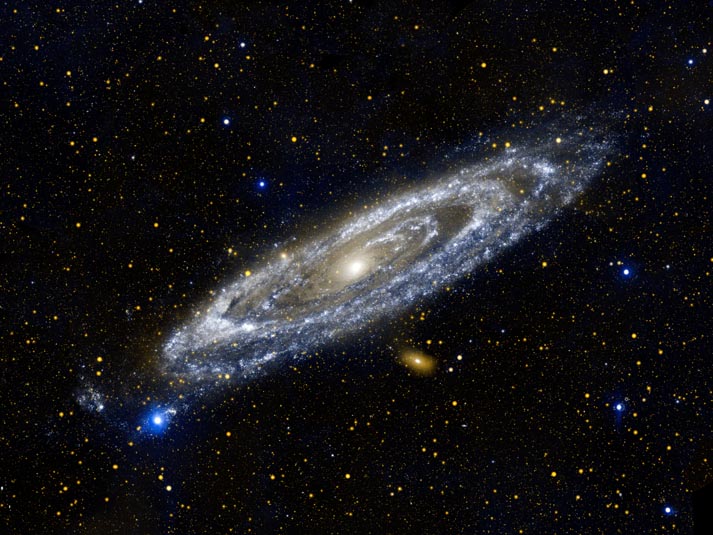
M31, Andromeda galaxy, NGC 224
Spiral Nebula
RA 00h 42m 44.3s Dec. +41°
16' 9"
Andromeda
2.54 ± 0.06 Mly (778 ± 17 kpc)
190 × 60 arcmin
3.44
NASA/JPL-Caltech
May 15, 2012
Spitzer image: G0624 Wise: G1004 Galex: G1205 Hubble:
G1502
ABOUT THIS IMAGE:
Hot stars burn brightly in this new image from NASA's Galaxy Evolution Explorer, showing the ultraviolet side of a familiar face.
At approximately 2.5 million light-years away, the Andromeda galaxy, or M31, is our Milky Way's largest galactic neighbor. The entire galaxy spans 260,000 light-years across -- a distance so large, it took 11 different image segments stitched together to produce this view of the galaxy next door.
The bands of blue-white making up the galaxy's striking rings are neighborhoods that harbor hot, young, massive stars. Dark blue-grey lanes of cooler dust show up starkly against these bright rings, tracing the regions where star formation is currently taking place in dense cloudy cocoons. Eventually, these dusty lanes will be blown away by strong stellar winds, as the forming stars ignite nuclear fusion in their cores. Meanwhile, the central orange-white ball reveals a congregation of cooler, old stars that formed long ago.
When observed in visible light, Andromeda's rings look more like spiral arms. The ultraviolet view shows that these arms more closely resemble the ring-like structure previously observed in infrared wavelengths with NASA's Spitzer Space Telescope. Astronomers using Spitzer interpreted these rings as evidence that the galaxy was involved in a direct collision with its neighbor, M32, more than 200 million years ago.
Andromeda is so bright and close to us that it is one of only ten galaxies that can be spotted from Earth with the naked eye. This view is a two-color composite, where blue represents far-ultraviolet light, and orange is near-ultraviolet light.
From
Wikipedia:
The Andromeda Galaxy is a spiral galaxy approximately 2.5 million light-years
(2.4×1019 km) from Earth in the Andromeda constellation.
Also known as Messier 31, M31, or NGC 224, it is often referred to as
the Great Andromeda Nebula in older texts. The Andromeda Galaxy is the
nearest spiral galaxy to our Milky Way galaxy, but not the closest galaxy
overall. It gets its name from the area of the sky in which it appears,
the constellation of Andromeda, which was named after the mythological
princess Andromeda. The Andromeda Galaxy is the largest galaxy of the
Local Group, which also contains the Milky Way, the Triangulum Galaxy,
and about 30 other smaller galaxies. Although the largest, the Andromeda
Galaxy may not be the most massive, as recent findings suggest that the
Milky Way contains more dark matter and could be the most massive in the
grouping. The 2006 observations by the Spitzer Space Telescope revealed
that M31 contains one trillion (1 x 1012) stars: at least twice the number
of stars in the Milky Way galaxy, which is estimated to be 200–400
billion.
The Andromeda Galaxy is estimated to be 7.1×1011 solar masses. In comparison, a 2009 study estimated that the Milky Way and M31 are about equal in mass, while a 2006 study put the mass of the Milky Way at ~80% of the mass of the Andromeda Galaxy. The two galaxies are expected to collide in 3.75 billion years.
At an apparent magnitude of 3.4, the Andromeda Galaxy is notable for being one of the brightest Messier objects, making it visible to the naked eye on moonless nights even when viewed from areas with moderate light pollution. Although it appears more than six times as wide as the full Moon when photographed through a larger telescope, only the brighter central region is visible to the naked eye or when viewed using binoculars or a small telescope